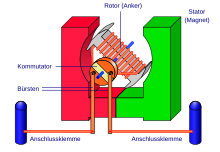Double-T anchor

The double-T armature is a simple form of armature - also called a runner or rotor - that is used in electric motors and generators . It consists of two mirror-inverted T-shaped iron cores around which a coil is wound.
History
This form of anchor was invented by Werner Siemens in 1856 . He used this invention to generate electricity in the telegraph apparatus manufactured on behalf of the Bavarian State Railways . In contrast to its predecessors, such a telegraph no longer required batteries, as the current was generated by crank movement when telegraphing itself. This invention was not only used in telegraphy, it was also the basis of the dynamo machine introduced by Werner von Siemens 10 years later . This machine was based on the dynamo-electric principle , which Siemens found independently of Samuel Alfred Varley and Charles Wheatstone . He was the first to publish this discovery in 1867.
Double-T anchors were used in the magneto ignition that Bosch had manufactured since 1887 and was installed in motor vehicles from 1897. Such an anchor is also stylized in the logo used by the Bosch company since 1919 .
Today's application
Today the double-T anchor is mainly used in electric motors designed for teaching purposes. Such a motor, however, needs starting help in order to start, since the forces do not act in the necessary direction in all positions of the armature; A triple T-anchor , the next simple anchor shape, can help.
Individual evidence
- ^ Deutsches Museum : Werner Siemens' dynamo machine
- ↑ Bosch Automotive: Product History at a Glance, Magazine of Product History ( Memento of the original from August 20, 2010 in the Internet Archive ) Info: The archive link was inserted automatically and has not yet been checked. Please check the original and archive link according to the instructions and then remove this notice.
